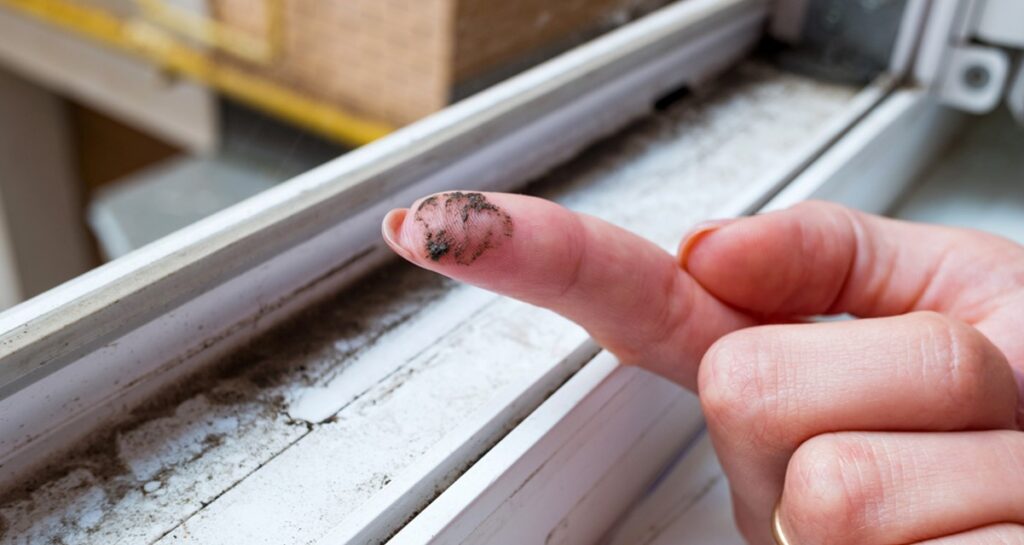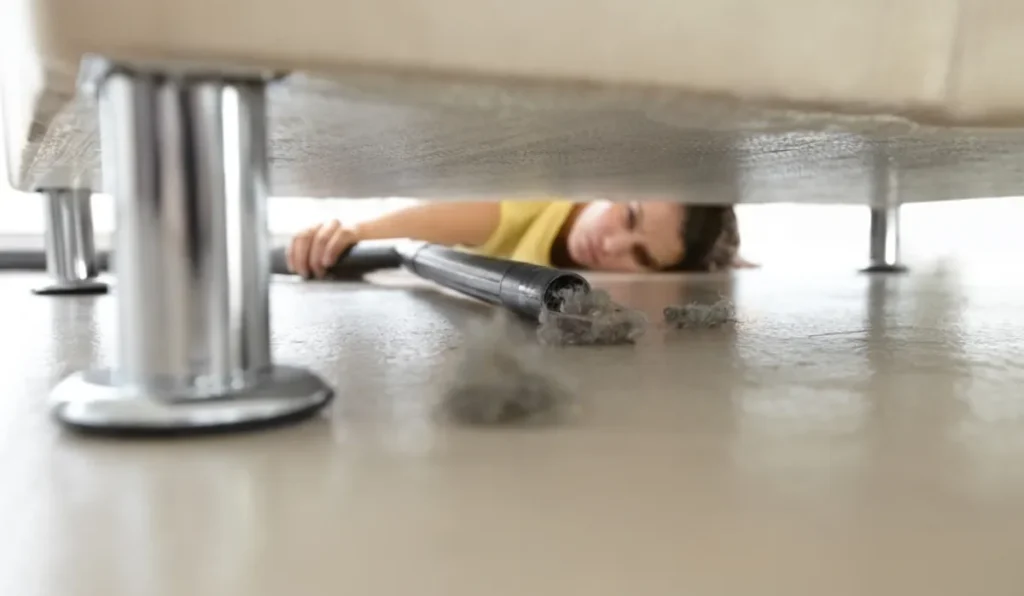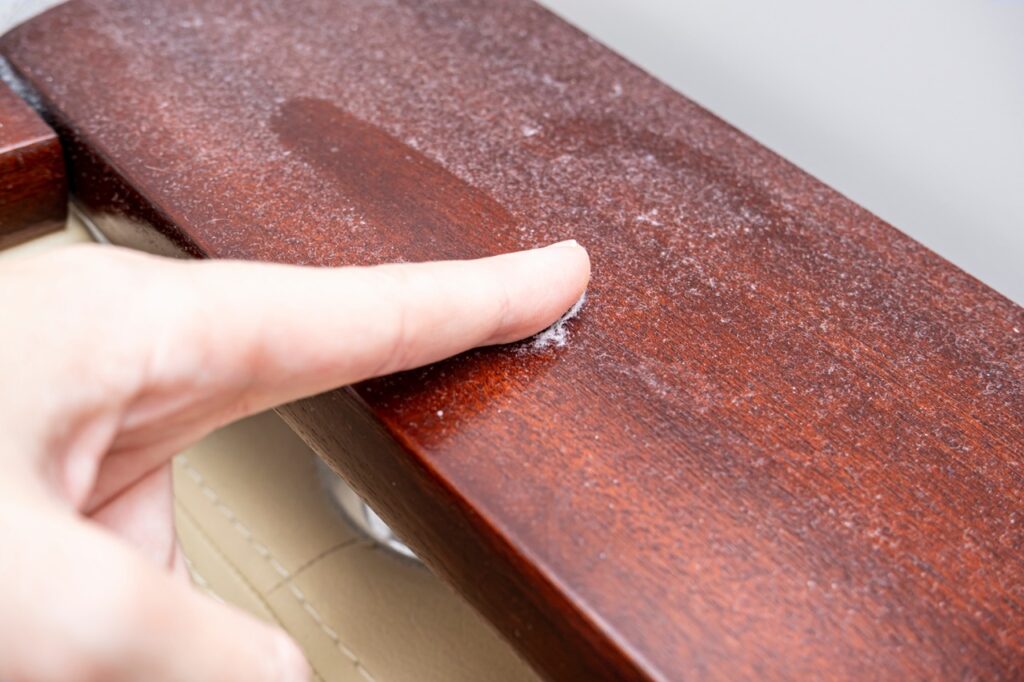Black dust in your house is usually caused by several factors. Common culprits include soot, which comes from wood-burning stoves, fireplaces, and even burning candles. Mold and mildew can also produce black dust, especially in moist areas like bathrooms or basements.
Moreover, poor ventilation can lead to the accumulation of black dust, as it doesn’t allow for proper air circulation. This prevents particles from being carried out of the house.
Aerosol sprays and coal dust can also contribute to black dust. Especially if you live near coal-processing facilities or use aerosol products excessively.
To prevent black dust, it’s essential to keep your home dry, clean and well-ventilated. Regular cleaning and maintenance of heating systems can also help mitigate black dust buildup.
Common Causes of Black Dust

Black dust in your house can be unsightly and, in some cases, potentially harmful. Here are some of the most common causes of black dust.
- When fuel doesn’t burn completely, it creates black soot.
- Reasons for incomplete combustion include lack of air, wrong fuel mix, or low fire temperature.
- Broken furnaces or boilers with dirty parts or blocked filters can produce soot.
- Burning wood in stoves or fireplaces without enough air or using wet wood can lead to soot buildup.
- Diesel engines emit black smoke with soot due to engine issues or faulty exhaust systems.
- Burning candles or incense in poorly ventilated areas can result in soot production.
- Indoor smoking can generate soot that settles on surfaces.
- Industrial processes like power generation and waste incineration can produce soot as a byproduct.
- Cooking with certain fuels or grilling with incomplete combustion can create soot.
- Improper candle making techniques can lead to soot production.
- Mold and mildew in poorly ventilated areas can form black dust.
- Aerosol sprays, if overused or in poorly ventilated spaces, can leave behind black residue.
- Living near busy roads exposes homes to traffic dust containing brake pad particles, tire wear, and exhaust fumes, which can contain harmful substances.
Identifying the Source of Black Dust

Identifying the source of black dust in your house is crucial for effectively dealing with the problem. Here are some steps you can take.
HVAC System Inspection
Your HVAC (heating, ventilation, and air conditioning) system is a common source of black dust. Start by checking the air filters. If they are dirty or clogged, they may be circulating dust and other particles throughout your home. Replace them if necessary.
Also, inspect the ducts and vents for signs of leaks or blockages. Leaky ducts or vents can pull in dust, dirt, and other contaminants from the surrounding areas. Blockages can also cause air to circulate inefficiently, leading to a buildup of dust and debris.
Moisture Levels
High humidity levels can contribute to the growth of mold and mildew, which can produce black dust. Look for signs of moisture or water damage in areas such as bathrooms, basements, and kitchens.
Further, address any leaks or dampness promptly to prevent mold growth. Consider using a dehumidifier in areas with high humidity to reduce moisture levels and inhibit mold growth.
Household Items
Black dust can also come from household items such as candles, fireplaces, and cooking appliances. If you use these items frequently, they may be contributing to the buildup of soot and other particles in your home.
In addition, make sure to clean and maintain them regularly to reduce dust and improve indoor air quality. For example, clean the chimney and fireplace regularly to prevent the buildup of soot. And use exhaust fans when cooking to remove cooking fumes and particles from the air.
Other Possible Sources
In addition to the HVAC system, moisture, and household items, there are other possible sources of black dust in your home.
For instance, dust mites can produce black dust, especially in areas with high humidity and poor ventilation. To reduce dust mites, wash bedding and curtains regularly in hot water, and use allergen-proof mattresses and pillow covers.
Also, consider using a vacuum cleaner with a high-efficiency particulate air (HEPA) filter to remove dust mites. Remove additional allergens from upholstery and carpets.
Professional Inspection
If you are unable to identify the source of the black dust or if the problem persists despite your efforts, consider hiring a professional. An experienced HVAC technician or indoor air quality specialist can perform a thorough inspection of your home and recommend appropriate solutions.
Moreover, they may use specialized equipment such as air quality monitors and thermal imaging cameras. To identify sources of dust and other contaminants.
Health Risks and Remediation

Black dust in your house may lead to several health issues. Exposure to mold spores, soot particles, or coal dust can irritate the respiratory tract, triggering coughing, sneezing, and breathing difficulties. It may worsen existing respiratory conditions like asthma or bronchitis.
Additionally, mold spores can cause allergic reactions, including skin rashes, eye irritation, and nasal congestion. Furthermore, coal dust may contain toxic substances like arsenic and mercury, posing long-term health risks if inhaled.
So, to mitigate these risks, ensure proper cleaning and ventilation in your home, consider professional inspections for mold or soot, and use personal protective gear when handling black dust. Taking these precautions can help maintain a healthier living environment.
FAQ’s
Is black dust harmful?
Carbon black particles can irritate the lungs, eyes, nose, and throat. Prolonged exposure can lead to lung diseases.
How do you get rid of black dust?
Vacuum dirty surfaces, soak fabrics in cold water before cleaning, and use a mixture of water and liquid dish soap with a degreaser to clean soot from surfaces.
Why is there black stuff on everything in my house?
Soot, resulting from incomplete combustion of carbon, can accumulate when carbon doesn’t burn cleanly.
What is black dust called?
Soot is the name for the mass of impure carbon particles resulting from incomplete hydrocarbon combustion.
Final Words
Black dust in your house can arise from various sources such as soot, mold, mildew, coal dust, or aerosol sprays. Regular cleaning, proper ventilation, and maintenance of heating systems are essential to prevent its accumulation.
Remember to address any sources of moisture promptly to prevent mold and mildew growth. Avoid overuse of aerosol products and ensure you are using them in well-ventilated areas.
So, by taking these steps, you can maintain a cleaner and healthier living environment for you and your family.
